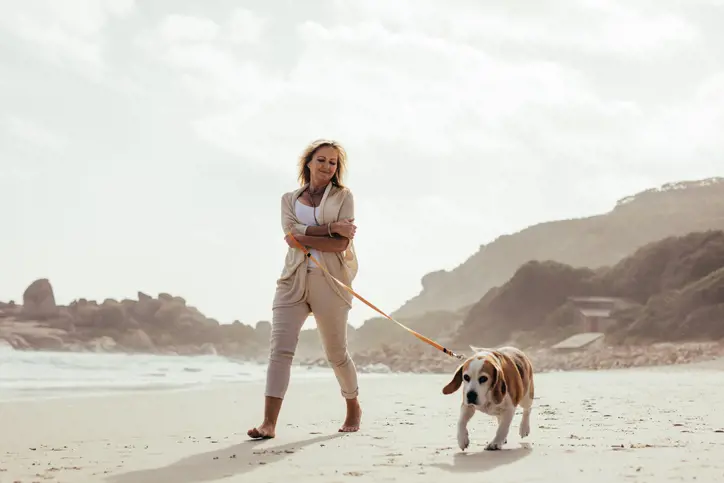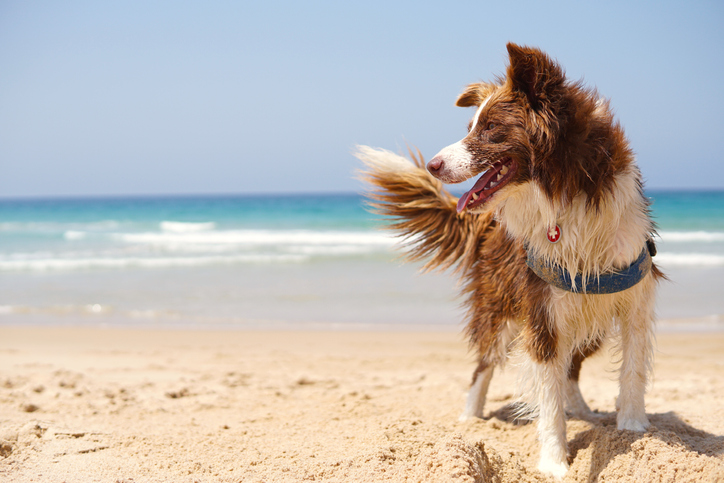Beach hazards for dogs
11th October, 2021

Everyone likes a trip to the beach, especially when our dogs come along for the ride. Beaches can be very happy places for our canine friends, with so much to explore – sea, sand, rolling dunes – and so much to do, from digging to paddling and chasing gulls along the shore.
Yes, beaches can make brilliant doggie playgrounds – but they’re not without their risks and dangers. Read on for our list of canine beach hazards for you and your canine chum to be aware of. The other great thing you can do to prepare for your day at the beach is to make sure that your pet insurance is up to date and able to help with some of the eventualities we’ll be listing below.
Eating sand
Yes, on occasion dogs have been known to eat a little bit of sand on visits to the beach. In fact, this happens most often by accident – they’ll be digging around or picking up a toy or ball, and inadvertently ingest some sand. That may sound harmless enough – however sand, if ingested in sufficient quantities, can block the intestine. If this happens to your dog (it’s called sand impaction), signs will include vomiting, dehydration and abdominal pain. Next step: the vet’s, and fast.

Walking on hot sand
Surely, under the UK’s mild sunshine, the sand doesn’t get up to dangerous temperatures? Actually, yes, it can, and if the sand feels too hot for you to walk barefoot, it will also be uncomfortable for your dog’s paws. Craving a visit to the beach on a hot summer’s day? Try to go in the early morning or late evening, when the sand should be a much more bearable temperature.
Sea swimming
Dogs love to swim, right? Right – but not all of them know how. Just like their owners, dogs need to learn to swim before they are competent in the water. Certain dog breeds, such as spaniels, are naturally good swimmers. Others – corgis and pugs, for example – not so much. You should head for some calmer water first, and make sure your dog is a comfortable swimmer, before you introduce them to sea swimming. Take a look at our blog on water safety tips for pets, to help ensure your dog has a safe, enjoyable time in the sea.
Fast tides and big waves
Following on from our last point, even strong swimmers could be at risk of being swept away by strong currents and big waves. This is something to be especially aware of on windy days, when the waves naturally crest higher. Keep a vigilant eye on your canine and make sure they don’t stray too far into the sea. Waves and currents will tire dogs out relatively quickly, and they may suddenly lose the capacity to get themselves out of trouble – you could even consider buying a life vest for your dog.
Salt water
So, your dog wanders into the shallow waves and starts lapping at the sea water. Nothing wrong with that, right? Well, in fact sea water contains a combination of salt, bacteria and parasites that can make dogs ill. To avert this danger, have plenty of fresh water to give your dog – dashing about on a windswept beach is thirsty work, and they will need lots to drink.
Salt water can also irritate dogs’ skin and paws, so a little fresh-water rinse before you leave the beach is a great idea.
Mudflats and low tides
On some beaches, especially those with a large tidal range, mudflats and small islands can be exposed at low tide, then covered over when the tide comes in. No surprise, then, that these can make for dangerous places, for both people and dogs. Steer well away from these zones – never try to get to the water’s edge at low tide, and check tide times before you head out so you know the safe, and unsafe, times of day to explore. And, while you’re in troubleshooting mode, make sure that you have an up-to-date pet insurance policy that can help cover your costs in the event of any misadventures.
Heat stroke
Sprinting around on the sand will take more out of your dog than a blitz around the local park with its nice firm grass: so bear in mind that overexertion (or tiredness) can quickly come into effect. Couple this with all that exposure to the summer sun, and you can see why heat stroke is a real risk. Don’t be fooled by that gentle coastal breeze either – temperatures will be high out on those beaches in summer, and there is rarely anywhere to get out of the full sun. Make sure your dog takes regular breaks from dashing around, keep them hydrated, and provide some shade such as a windbreak or parasol.
Sunburn
Just like their owners, dogs can get sunburn. Breeds that are particularly susceptible include those with short hair or white hair (such as Dalmatians, whippets, greyhounds and Jack Russells), while dogs with pink ears also need to be monitored closely on hot, sunny days. Luckily, there are sunscreens for dogs available – but the usual advice applies about making sure that they’re not out in that hot sun for long periods at a time.
Beach debris
In the right weather, beaches are heavily frequented places – and, as a result, there’s always plenty of paraphernalia on the beach, from picnics and rubbish to beach toys. Keep an eye on your dog and make sure they’re not likely to take a nibble out of something they shouldn’t.
Jellyfish
These strange creatures present another potential danger for your dog while truffling around the beach. Jellyfish keep themselves to themselves, either hanging around in the shallows or washed up on the shore. They will look harmless enough – but they can pack quite a sting. Again, seek veterinary advice if your dog gets on the wrong end of one of these translucent troublemakers.
Seaweed
Seaweed is a rich source of minerals and vitamins, surely? Well, yes – but in its dried form, as found on countless British beaches, seaweed can actually be dangerous, rather than nutritious, for dogs.
When swallowed, it can expand in the stomach and get itself embedded in an animal’s intestine. Likewise, seaweed stalks can be incredibly dangerous if eaten as they can cause a blockage. A small amount may be harmless enough – but if you suspect that your dog has ingested large quantities of seaweed, this is another instance where a call to the vet is strongly recommended. It’s a good idea to make sure that your pet insurance can help cover you for any vet’s bills incurred.
Fishing hooks
This is one to bear in mind if your dog-walking beach is a popular fishing spot. Be on the lookout for discarded fish hooks as, unfortunately, the shiny lures with their tasty-looking bait can often tempt unwary dogs to swallow them. Swallowing one of these sharp hooks can result in painful injuries if they become lodged in your pet’s mouth, food pipe or stomach. If your dog steps on a hook while running around, the injury to their paw could be painful and could attract infection if not dealt with swiftly.
Dead fish
Your dog is likely to snuffle curiously around any dead fish washed up on the beach. Just exercising his natural curiosity? Yes, but be careful. Dead fish can contain toxins, and these may be deadly. Best steer your beloved pet away from any fishy remains.

Is my dog welcome on any beach?
A good question. Essentially, dogs are allowed on most UK beaches outside the summer months – so, from 1st October to 30th April. A smaller selection of beaches, however, welcome dogs all year round – and the helpful people at The Beach Guide have compiled a list of these year-round, dog-friendly beaches.
It turns out that the English county with the biggest number of dog-friendly beaches is Devon, with an impressive 68, including such well-loved beaches as Slapton Sands and St Mary’s Bay on the south coast, and Clovelly and Lynmouth on the north.
Clicking on each county on the link above gives you a helpful county map with the beaches colour-coded into green (dogs welcome all year round), grey (certain restrictions in place – either the summer ban or the need for dogs to be on leads), or red beaches, where dogs are not allowed at all. Again, Devon scores well here – there are just three beaches across the county that don’t welcome dogs at all.
Other counties blessed with plenty of dog-friendly beaches include Cornwall, with 54, and Dorset, with 30. Cornwall has more red beaches than its Devon neighbour however, so be aware that the beaches at Tolcarne, Polurrian Cove, Crinnis, Duporth and East Looe may not welcome your canine friend.
Over in Wales, Pembrokeshire has a hugely impressive 81 beaches where you and your companion are welcome all year round. Not only that, not a single beach across the county operates an outright ban on dogs, and only a few bar them during the summer months.
Beaches across Scotland also welcome dogs, including – if you and your dog don’t mind those chill northern winds – no fewer than 33 across the Highland region.
5 great dog-friendly beaches
-
Woolacombe, Devon
North Devon’s Woolacombe beach is justly famous, sited within an Area of Outstanding Natural Beauty and a winner of both the Premier Seaside Beach and Blue Flag awards. Both you and your dog will love it here: there are three miles of clean, golden sand, making the perfect playground (imagine the game of ‘Fetch!’ you can play on that expanse!), while the rock pools and shallow areas are a great place for both exploring and having a quick wash.
-
Hunstanton, Norfolk
Cleanliness is the watchword at Hunstanton: the beach is cleaned every day, which means it’s the perfect safe, clean backdrop for your dog’s beach workout. The shallow water along this stretch of coast is perfect paddling territory, while the rock pools and formations are filled with interest for humans and canines alike.
-
Camber Sands, Sussex
Camber has an impressive two-mile stretch of golden sand – but almost as exciting, for your furry friend, will be the extensive network of dunes that lies just behind the beach. Dunes make a great place for exploring (in short stretches at a time – scrabbling up and down those sandy hillocks will get tiring pretty quickly!). The nearby village of Camber also has several dog-friendly cafes where you can both relax after your exertions.
-
Rhossili Bay, Gower, South Wales
Walking, watersports and amazing views: there’s something for everyone at Rhossili. You and your dog will most enjoy the three miles of golden white sand – a perfect pooch’s playground.
-
Luskentyre, Isle of Harris, Scotland
Beaches don’t come much wilder than Luskentyre, on the western shore of the Isle of Harris in Scotland’s Outer Hebrides. The green hills that surround the beach make a startling contrast to its creamy white sands: among the dunes, meanwhile, you’ll find a rich variety of birdlife, including red-breasted mergansers and beautiful long-tailed ducks.
Pet insurance with Purely Pets
We hope you and your beloved pet have many memorable hours of fun on Britain’s beaches ahead of you. We also hope that, with the help of this article, your dog’s beach times are as safe as they are exciting.
We love our pets here at Purely Pets, and we are delighted to be able to provide a wide range of pet insurance policies that give owners and their pets the cover that they need. Some of the benefits of taking out pet insurance with us include:
-
24-Hour Vet Helpline
-
Multiple options for lifetime cover
-
Excess from £60
-
No upper age limit for joining
Why not get in touch with us today for a pet insurance quote?
Policy benefits, features and discounts offered may very between insurance schemes or cover selected and are subject to underwriting criteria. Information contained within this article is accurate at the time of publishing but may be subject to change.
Helpful Pages
Recent Posts
Pet Insurance Quote
- 98% claims paid *
- Claims paid directly to vets
- 24/7 vet video consultations
- Interest free monthly payments




